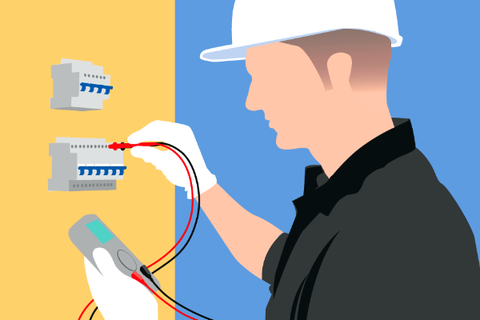This article aims to provide guidance on the safe and accurate use of electrical testing equipment.

Electrical testing inherently involves a degree of risk and those undertaking such work have a duty to ensure the safety and accuracy of the electrical test equipment they use.
Safety
The safe testing of circuits requires strict adherence to safe working practice, including checking that the test equipment and leads are safe and suitable for the intended purpose, that the equipment to be tested is safe for the tests, and that the working environment does not impair safety.
It is important to appreciate there is a potential danger of electric shock not only from electricity supplies, but also from voltages generated within test instruments, from stored energy devices such as uninterruptible power supplies, and from capacitive loads. Particular care is needed where there are alternative sources, such as from standby generators and uninterruptible power supplies.
Safe isolation procedures
Regulation 12 of the Electricity at Work Regulations 1989 (EWR), requires that where necessary to prevent danger, suitable means including, where appropriate, methods of identifying circuits are made available for:
- cutting off the electrical supply of electrical energy to any electrical equipment, and
- the isolation of electrical equipment.
Prior to conducting dead tests, such as continuity and insulation resistance tests, it should be confirmed that the circuits to be tested have been securely isolated.
Information on procedures for safe isolation is contained in the NICEIC and ELECSA Pocket Guide 5. For guidance on the safe use of electrical test equipment refer to HSE Guidance Note GS 38: Electrical test equipment for use by electricians.
Regulation 14 (work on or near live conductors) of the Electricity at Work Regulations will often apply to electrical testing.
Instrument accuracy
It is essential to ensure the accuracy and consistency of test instruments used to carry out the range of tests and measurements required by BS 7671 for certification and reporting purposes. There should be a system in place which enables confirmation of the continuing accuracy and consistency of all test instruments used for certification and reporting purposes. There are several alternatives for such a system, including:
- Maintaining records over time of comparative cross-checks with other test instruments.
- Maintaining records over time of measurements of the characteristics of designated reference circuits or devices.
For example, the consistency of continuity, insulation resistance and earth electrode test instruments can be checked against a proprietary resistance box or a set of suitable resistors. Earth fault loop impedance test instruments can be checked by carrying out tests on a designated socket-outlet (on a non-RCD protected circuit) in a particular office. RCD test instruments can be checked by carrying out tests on an RCD unit plugged into the designated socket-outlet.
Either of these systems will provide a measure of confidence in the consistency of test measurements over time. However, before any reliance is placed in such systems, the accuracy of each test instrument first needs to be confirmed, such as by formal calibration/re-calibration supported by calibration certificates issued by recognised organisations, with measurements traceable to national standards. Certificates issued by UKAS accredited laboratories are preferable.

It should be noted that new or repaired test instruments may not be supplied with calibration certificates unless specifically requested. Another alternative is simply to maintain records of the formal calibration/recalibration of test instruments at the intervals recommended by the instrument manufacturers, supported by calibration certificates.
However, given the arduous conditions in which test instruments often have to be used, such a system will not provide any assurance of continuing accuracy and consistency over the period between the formal calibration checks.
For these reasons, the continuing condition and accuracy of electrical test equipment should be checked regularly and a log of the results maintained.
For other guidance and publications please see the NICEIC website. For information about the NICEIC Approved Contractor or Domestic Installers schemes, visit www.niceic.com
